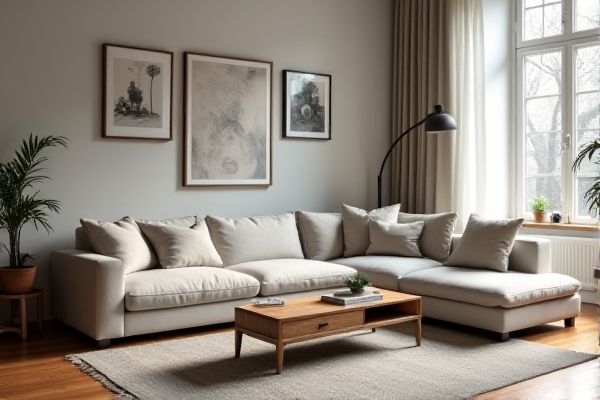
A corner sofa is designed to fit snugly into the corner of a room, maximizing space with seating that wraps around two walls, while an L-shaped sofa offers flexible arrangements that can be placed away from corners or in open spaces, often featuring a longer chaise for lounging. Explore the full article to understand which style best suits Your living room layout and lifestyle needs.
Table of Comparison
| Feature | Corner Sofa | L-Shaped Sofa |
|---|---|---|
| Design | Forms a right angle, designed to fit snugly in corners | Typically has one longer and one shorter section forming an "L" |
| Space Utilization | Maximizes corner space, ideal for small rooms | Works well in open spaces and larger rooms |
| Seating Capacity | Usually seats 4-6 people | Seating varies, usually 5-7 people |
| Flexibility | Less modular, fixed shape | Often modular and adaptable |
| Comfort | Cozy corner seating, ideal for lounging | Offers more open seating arrangement |
| Placement | Best placed directly in room corners | Can be positioned in room corners or as room dividers |
Introduction to Corner Sofas and L-Shaped Sofas
Corner sofas and L-shaped sofas both maximize seating by utilizing room corners effectively, but they differ in design and flexibility. Corner sofas typically have a built-in angled section creating a distinct corner seat, while L-shaped sofas consist of two sections joined at a right angle, offering modular arrangements. Your choice depends on available space and desired seating capacity for optimal comfort and functionality.
Key Design Differences
Corner sofas typically feature two equal-length sections that meet at a right angle, forming a perfect square or rectangular seating area ideal for maximizing space in smaller rooms. L-shaped sofas, on the other hand, often have one longer side and one shorter side, offering a more versatile layout that can define the shape of a room or separate living areas. The key design difference lies in the proportional balance and spatial function, with corner sofas emphasizing compactness and L-shaped sofas providing extended seating and room division.
Space Efficiency and Room Layout
Corner sofas maximize space efficiency by fitting snugly into room corners, making them ideal for small or irregularly shaped spaces. L-shaped sofas offer flexible room layout options, allowing for separation between seating areas and pathways. Choosing between the two depends on the room's dimensions and the desired traffic flow, with corner sofas optimizing compact areas and L-shaped sofas enhancing open-plan spaces.
Comfort and Seating Capacity
Corner sofas offer versatile seating arrangements that maximize space and comfortably accommodate larger groups, ideal for living rooms requiring both style and functionality. L-shaped sofas provide ample seating with a distinct angular design that fits snugly into room corners, enhancing comfort through extended lounging areas. Both options deliver superior seating capacity, but corner sofas often offer greater flexibility in layout and user comfort.
Style and Aesthetic Appeal
Corner sofas offer a sleek, modern aesthetic that maximizes seating while maintaining a cohesive look, making them ideal for contemporary interiors. L-shaped sofas boast versatility with defined angles that create distinct zones, enhancing both style and functionality in diverse room layouts. Your choice will influence the room's flow and visual balance, as corner sofas tend to blend seamlessly, while L-shaped sofas make a bold statement.
Customization Options
Corner sofas offer extensive customization options including modular sections, various fabric choices, and adjustable features like reclining seats or built-in storage. L-shaped sofas provide fewer modular configurations but excel in tailored fits for specific room dimensions, often allowing you to select armrest styles and cushion firmness. Your choice depends on whether you prioritize flexibility in design or a precise fit for your living space.
Practicality and Functionality
Corner sofas maximize seating space by fitting snugly into room corners, making them ideal for small to medium-sized living areas that require efficient use of space. L-shaped sofas offer versatile configurations with extended chaise sections, providing both seating and lounging options that enhance comfort and usability. Both types deliver practical solutions for optimizing room layout while supporting diverse functional needs such as relaxation, socializing, and accommodating guests.
Price Comparison
Corner sofas generally offer a wider range of price points due to their versatility and size variations, with budget models starting around $300 and luxury options exceeding $3,000. L-shaped sofas tend to be more affordable on average, often priced between $400 and $2,500, as their design typically requires less material and simpler construction. Consumers should consider factors such as fabric, frame quality, and included features when comparing cost-effectiveness between corner and L-shaped sofas.
Maintenance and Durability
Corner sofas often feature modular components that allow for easier cleaning and replacement of individual parts, enhancing long-term durability. L-shaped sofas generally have a single frame, which can provide robust structural integrity but may be more challenging to maintain if stains or damage occur in the connecting corner. Choosing high-quality upholstery materials like leather or performance fabric can significantly improve the lifespan and ease of maintenance for both sofa types.
Choosing the Right Sofa for Your Home
Choosing the right sofa for your home depends on space availability and seating needs; corner sofas maximize seating in compact areas while L-shaped sofas provide a more open layout suitable for larger rooms. Corner sofas fit snugly into room corners, making them ideal for small or awkward spaces, whereas L-shaped sofas create defined zones in open-plan living areas. Considering room shape, traffic flow, and desired comfort levels ensures the best fit between a corner sofa and an L-shaped sofa.
 homyna.com
homyna.com